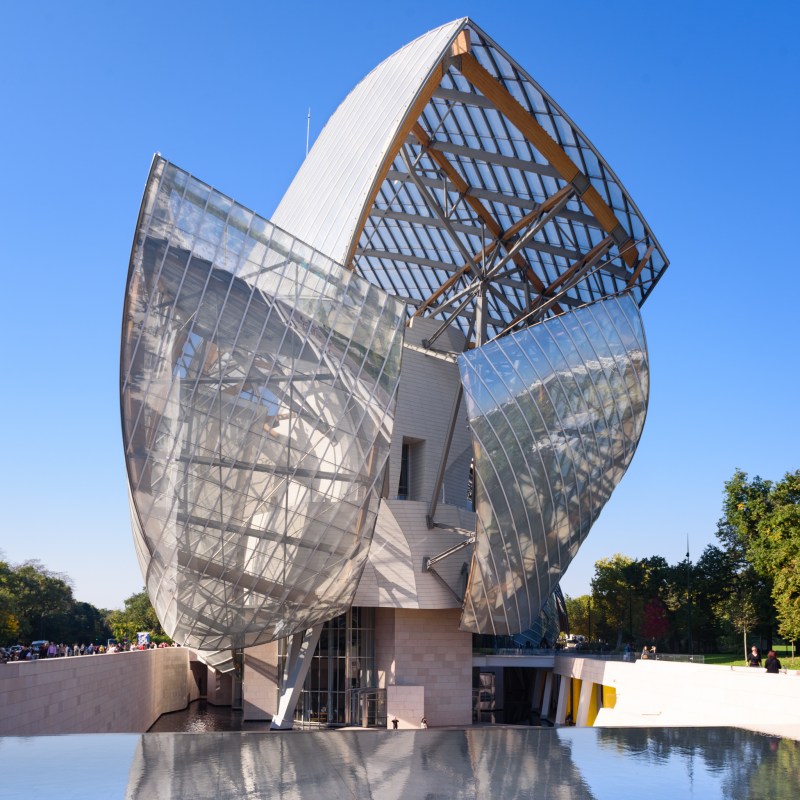
Paris is best loved for its magnificent honey-hued Haussmann-style buildings and smaller, crooked houses with their iconic chimneys and shuttered windows. The history that oozes from the buildings — plus the romance that is inspired by architecture where no floor is the same as the next — makes you dream about living under the slanted roofs or standing on one of the wrought-iron balconies overlooking the Eiffel Tower.
Videos by TravelAwaits
In between the traditional Parisian buildings we love sit a few odd intruders that at first glance look out of place. Just think of the modern glass pyramid by I. M. Pei in front of the Louvre. Think of the striped and oh-so-photogenic columns that stand within the elegant Palais Royal, or the inside-out colossus that is the Centre Pompidou.
These structures took Paris by surprise — residents and visitors alike — and it took years before the modern edifices were accepted.
If you ask me what I love most about Paris, I’d have to say the architecture. I live in a honey-hued Haussmann building in an apartment with very high ceilings adorned with stucco, old wood floors, and double windows with shutters, and I sigh each time I look out over the little chimneys that are so typical of Paris. But, despite that, I also love walking around the 13th arrondissement with its amazing modern apartment blocks in all colors, where every angle is different from the next. I love turning a corner and finding a building that does not fit the norm and stands distinct from the typical Parisian architecture. For me, it is the mix that makes the city perfect.
Let me introduce you to some of my favorite modern architectural wonders within the city limits of Paris.

1. Louis Vuitton Foundation
Let’s start with one building known not just for its architect but also the art it contains: the privately owned Louis Vuitton Foundation. The $143 million structure is so unique that, at times, it distracts from the art within.
Reportedly inspired by the old glasshouses that used to stand in the park next door, its white concrete segments also resemble sails (especially noticeable when viewed from the park), clouds, and icebergs. Since the mirrored glass reflects the surroundings, it is interesting to visit the building in all kinds of weather.
Inside, various levels and courtyards make the building a sort of maze; a few rooms are dedicated to the construction of the foundation for those interested in a behind-the-scenes look. The superb art on display is just a bonus, really.
Pro Tip: Your ticket also grants admission to the Jardin d’Acclimatation. Just leave through the back entrance rather than the front.

2. Paris Philharmonic
Jean Nouvel, who designed the Louvre Abu Dhabi and the National Museum of Qatar, is also responsible for the shimmering Paris Philharmonic on the northeastern edge of Paris. This silvery hunk of a building overlooking the sprawling Parc de la Villette looks at first as if something has gone wrong with the silver-plating, but look closely, and you’ll realize that the roof is embellished with thousands of birds taking flight. Get up really close, and you’ll see that the design is nothing short of breathtaking. Inside, the concert hall reminds me a little of an intricate wasp’s nest — in a good way.
The museum inside the building showcases thousands of instruments from around the world, and there are regular events and concerts at which you can appreciate the harmonics of the hall.

3. Arab World Institute
The Arab World Institute, designed by Architecture Studio together with Nouvel, is one of my favorite buildings in Paris. At first glance, the institute looks like your average glassy cube office tower, but the Arabian-inspired metal squares hold a secret: They are actually 240 photo-sensitive shutters that react to sunlight and automatically open and close their apertures, thus controlling the amount of light and heat entering the building from the outside. Inside, when you are visiting one of the exhibits, you’ll see and hear them move.
What makes this building even more special is that it sits in between the oldest parts of Paris — the Roman remainders, such as the Arenes de Lutece, and the inner-city islands, where Paris began. Walking from Roman to modern times is really quite special.
Pro Tip: Treat yourself to dinner in the Le Zyriab restaurant on the top floor of the institute. It looks out across the Ile Saint-Louis and Ile de la Cite.

4. Fondation Le Corbusier
Controversial yet brilliant architect Le Corbusier designed his first important buildings in Paris in 1923: Maison La Roche and Maison Jeanneret, neighboring private houses located in a cul-de-sac in the 16th arrondissement of Paris. Now home to the Fondation Le Corbusier, Maison La Roche is open to visitors, while Maison Jeanneret holds the foundation’s offices.
Pro Tip: There are many examples of Le Corbusier’s work dotted around Paris. Ask for a map at the Fondation Le Corbusier. One of my favorites is Villa Savoye in Poissy-sur-Seine. A picture-perfect example of his essential design points, the white villa sits in lovely gardens, with an equally well-designed house for the gardener of the plot near the entrance.

5. Grande Arche De La Defense
In the modern business suburb of La Defense stands the Grande Arche, which sits in a line with the Arc de Triomphe and the Arc de Triomphe du Carrousel. The brainchild of former President Francois Mitterrand, it was inaugurated on July 14, 1989, to commemorate the bicentenary of the French Revolution. Designed by a Danish team, architect Johan Otto von Spreckelsen and engineer Erik Reitzel, the arch stands 360 feet tall with fabulous views across Paris and the countryside from the 34th floor.
Pro Tip: If you head down from the ticket office on the escalator, you will find an art installation by Daniel Buren, whose striped pillars I mentioned in the introduction. These 50 pillars are black and white on one side, blue on another, and pink on yet another.

6. Clichy-Batignolles Ecodistrict
This is not just a building, but an entire district, and an ecodistrict to boot. In the north of Paris, in the 17th arrondissement, lies the modern Martin Luther King Park, and around are some of the most interesting buildings in Paris.
Developed on former railway land, the Clichy-Batignolles Ecodistrict was intended to be model of sustainable urban development, promoting energy efficiency through the use of geothermal and solar energy, collecting rainwater to fill some 40 percent of the park’s needs, reducing greenhouse gas emissions, and encouraging biodiversity. The architecturally varied residential buildings around the square are green — some quite literally — and have a feel-good factor that is missing from many city apartment blocks, even trendy-looking ones.
Pro Tip: If you visit in the spring, this park is one of the best places to see cherry blossoms in Paris.

7. Ministry Of Culture
The Ministry of Culture comprises two buildings, a classic Haussmann-style building and a 1960s building. To merge these two buildings, architects Francis Soler and Frederic Druot wrapped both buildings in a metal lattice, uniting them without surrendering their original identities. The heirs of the original architect of the classic Parisian beauty built in 1919 took the Ministry of Culture to court for disfiguring the original buildings. Long story short, the court ordered the ministry to pay a symbolic 1 euro to the heirs.
Pro Tip: If you sit on the terrace of Le Cafe Blanc, you can marvel at the building just a stone’s throw away from the Palais Royal and the Louvre.
Want to enjoy more of Paris off the beaten path? Check out these hidden gems, delightful shops, surprising things to do, and lesser-known churches in the city.
